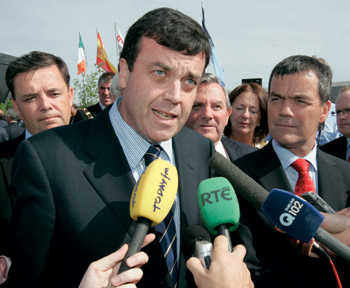Fourth time unlucky for Lenihan?

With government spending vastly outweighing projected tax intakes, further fiscal fudge has become nigh impossible for Brian Lenihan, writes Dan White.
15 September 2010
As he begins work on his fourth budget the shine is rapidly coming off Brian Lenihan. While up to now our Finance Minister has largely succeeded in avoiding the blame heaped on the rest of the government for the economic meltdown, that will almost certainly begin to change as circumstances continue to worsen.
As ministers returned from their long holidays at the beginning of this month the countdown to next December’s budget began in earnest. With the economy continuing to worsen and a growing public realisation that, after more than two years of blood, sweat and tears, things are still getting worse, it’s going to be Lenihan’s toughest budget by far.
All spent up?
On current trends the government will spend about €55bn on day-to-day or current spending this year. It will spend a further €7bn on debt servicing and other costs and €6.7bn on capital projects, a total of almost €69bn. As against that it now looks like it will collect just €32bn in tax revenues and a further €9.5bn in PRSI and health contributions.
Even when other government receipts and non-tax revenues are taken into account, that translates into a government borrowing requirement of more than €19bn. Virtually unchanged from 2009. And that doesn’t include any of the €25bn-plus that the government is squandering on that financial black hole previously known as Anglo Irish Bank.
Even if one accepts Brian Lenihan’s figures at face value it is difficult to see how we can claw our way out of the hole our politicians and trade union leaders have dug for us. Despite a €4bn package of tax increases and spending cuts in his December 2009 budget, a planned €3bn of further tax increases and spending cuts in next December’s budget, and more of the same the whole way out to 2014, there is still no sign of things getting any better.
The government hopes to have reduced its borrowing requirement, excluding the contribution to the National Pension Reserve Requirement and a number of other items, to €6bn by 2014, an estimated 2.9% of that year’s projected GDP. In your dreams Brian.
Postponing the inevitable
If Lenihan’s austerity package, which would in total remove almost €20bn from the Irish economy between 2008 and 2014 had a realistic chance of restoring order to the public finances and preventing national bankruptcy then the sacrifices might be worth it. But will it?
Unfortunately, probably not. On closer examination there is much less to Lenihan’s public spending cuts than meets the eye. In 2014 current spending is projected by the Department of Finance to be €55bn, unchanged from the total for either 2009 and 2010. In fact most of the “cuts” in current spending turn out to be no such thing, consisting in the main of measures to postpone increases in spending that would otherwise have occurred.
At the same time as current spending will remain unchanged, the cost of servicing the national debt will soar from €6.9bn this year to almost €11bn by 2014.
Relying on tax increases
So how, in the absence of meaningful public spending cuts does the government propose to balance its books over the next four years? Lenihan and his colleagues are largely relying on a combination of an increase in tax revenues from €31bn (excluding PRSI and other levies) in 2010 to €39.5bn in 2014 and a cumulative 28.75% increase in the value of Irish GDP from €161bn to €207bn over the same period.
Am I alone in thinking that such projections are hopelessly optimistic? Despite the tax increases of the past two years, the tax take (excluding PRSI and levies) has actually declined from almost €41bn in 2008 to an expected €31bn this year. To achieve the government’s target tax revenues would have to increase by 27% in just four years.
In practice the government seems to be relying on renewed economic growth to boost tax revenues so that it doesn’t have to take the hard decisions on public spending.
Inherent implausibility
Sorry lads that won’t wash. No country ever taxed its way to recovery. Tax revenues increase when the economy recovers, not the other way round. If the government attempts to close the gap in the public finances by increasing taxes by more than a quarter it will further deepen the recession.
The growing realisation of the inherent implausibility of the government’s budget forecasts has been one of the major reasons that public and investor confidence that we can somehow tax our way out of difficulties has finally cracked. Even those who were prepared to give Brian Lenihan, a patently decent man who played no part in the decisions that have resulted in our current disastrous predicament, the benefit of the doubt have finally had enough.
When the history books come to be written, Tuesday, 24 August could turn out to be one of the key dates. While rating agency Standard & Poor’s decision to cut Ireland’s credit rating hardly came as any surprise, the reaction most certainly did. The heavy selling of Irish government bonds in the aftermath of the announcements clearly signalled that the bond markets have lost faith in the government’s ability to sort out Ireland’s problems.
And it isn’t just the moneymen who have lost faith in the government. So have Joe and Mary Public. Almost two years on from the bank guarantee there is still no light at the end of the tunnel. The government’s non-policy of putting off painful public spending cuts in the hope that economic recovery will boost tax revenues instead is both intellectually and financially bankrupt.
The honeymoon’s over
All of which leaves Brian Lenihan in a terrible pickle as he tries to frame the 2011 budget. With the bond markets openly sceptical and his extended honeymoon as Finance Minister having finally come to an end, further fiscal fudge has become increasingly difficult if not impossible. Meanwhile, with a general election at most 20 months away, the appetite of either Fianna Fail or the Greens for radical measures, never very great, has now completely disappeared.
In practice things could come to a head well before December. When one adds this year’s forecast year-end official national debt of €95bn, the €90bn cost of bailing out the banks and the €120bn of the Irish banks’ loans that aren’t covered by domestic deposits, the effective debt of the Irish state is now well over €300bn. That’s almost two-and-a-half times our GNP, the only meaningful measure of Irish economic output which is now down to under €130bn, and ten times annual tax revenues.
Ireland now has the fiscal profile of a state that has fought and lost a major war. This makes debt default, accompanied sooner or later by our ejection/withdrawal from the euro, an increasingly likely prospect.
It is in the nature of financial crises that, after a long gestation period, a tipping point is reached. Once this tipping point is reached, events move with terrifying speed. How close are we to such a tipping point? A lot closer than we might like to think.



 Print
Print






Fans 0
Followers